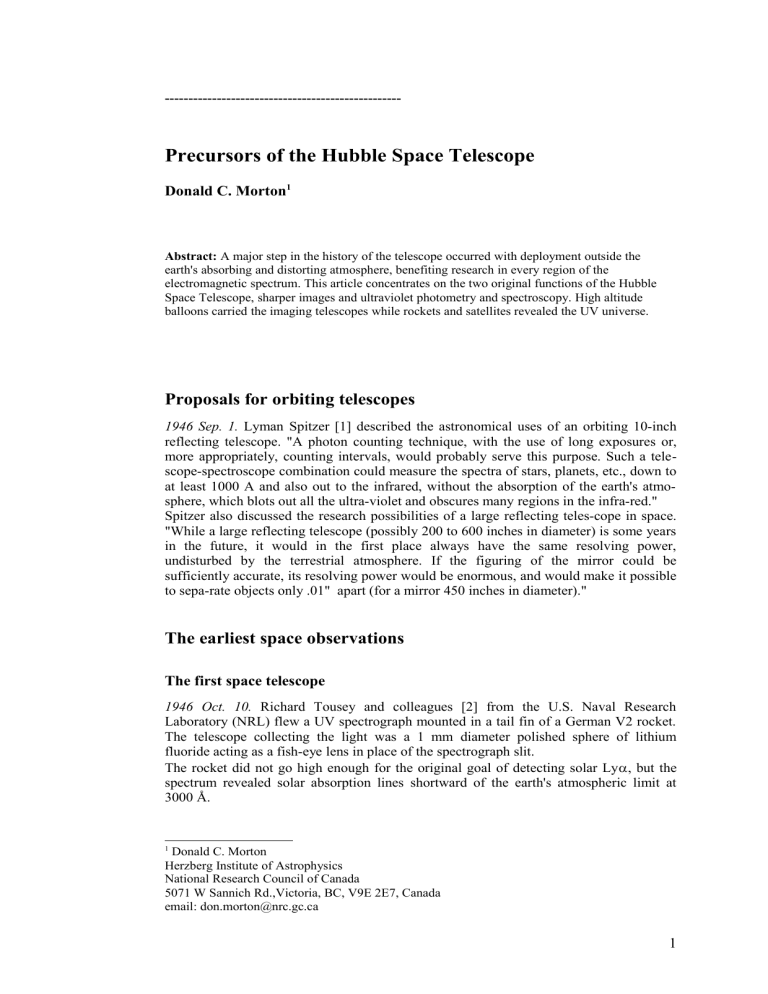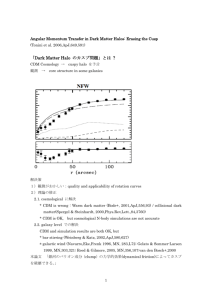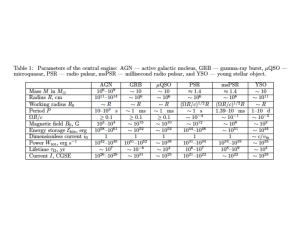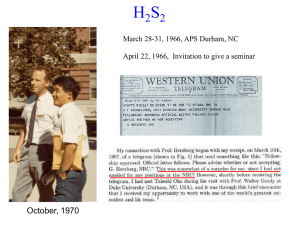Precursors of the Hubble Space Telescope ton --------------------------------------------------

--------------------------------------------------
Precursors of the Hubble Space Telescope
Abstract: A major step in the history of the telescope occurred with deployment outside the earth's absorbing and distorting atmosphere, benefiting research in every region of the electromagnetic spectrum. This article concentrates on the two original functions of the Hubble
Space Telescope, sharper images and ultraviolet photometry and spectroscopy. High altitude balloons carried the imaging telescopes while rockets and satellites revealed the UV universe.
Proposals for orbiting telescopes
1946 Sep. 1.
Lyman Spitzer [1] described the astronomical uses of an orbiting 10-inch reflecting telescope. "A photon counting technique, with the use of long exposures or, more appropriately, counting intervals, would probably serve this purpose. Such a telescope-spectroscope combination could measure the spectra of stars, planets, etc., down to at least 1000 A and also out to the infrared, without the absorption of the earth's atmosphere, which blots out all the ultra-violet and obscures many regions in the infra-red."
Spitzer also discussed the research possibilities of a large reflecting teles-cope in space.
"While a large reflecting telescope (possibly 200 to 600 inches in diameter) is some years in the future, it would in the first place always have the same resolving power, undisturbed by the terrestrial atmosphere. If the figuring of the mirror could be sufficiently accurate, its resolving power would be enormous, and would make it possible to sepa-rate objects only .01" apart (for a mirror 450 inches in diameter)."
The earliest space observations
The first space telescope
1946 Oct. 10.
Richard Tousey and colleagues [2] from the U.S. Naval Research
Laboratory (NRL) flew a UV spectrograph mounted in a tail fin of a German V2 rocket.
The telescope collecting the light was a 1 mm diameter polished sphere of lithium fluoride acting as a fish-eye lens in place of the spectrograph slit.
The rocket did not go high enough for the original goal of detecting solar Ly α , but the spectrum revealed solar absorption lines shortward of the earth's atmospheric limit at
3000 Å.
1 Donald C. Morton
Herzberg Institute of Astrophysics
National Research Council of Canada
5071 W Sannich Rd.,Victoria, BC, V9E 2E7, Canada email: don.morton@nrc.gc.ca
1
Fig. 1 The NRL photograph of the first solar UV spectrum recorded above the ozone layer.
Stratoscope I
(Fig. 2 near here)
1957 Sep 25 . Martin Schwarzschild [3] of Princeton University wanted to measure the size of the solar granulation in order to estimate the convec-tive mixing length for his stellar structure calculations. Ground photographs had insufficient resolution so he flew a
30 cm telescope suspended from a balloon at 25 km altitude. The diffraction-limited telescope made by the Perkin Elmer Corp. gave superb images with 0.38 arcsec resolution.
Fig. 2 Solar granulation photographed with the Princeton Stratoscope balloon telescope at 25 km.
Sputnik and NASA
1957 Oct. 4 . The Soviet Union launched the first artificial satellite. The United States already was preparing its Vanguard satellite for the Inter-national Geophysical Year, but the easily visible Sputnik with its persistent radio beep stimulated major increases in government support of scientific training and research in many free countries.
1958 Jul. 29.
President Eisenhower signed the legislation establishing the U. S. National
Aeronautics and Space Administration (NASA).
1959 Feb.
Nancy Roman left NRL to join the new NASA Headquarters staff as Head of
Optical Astronomy and soon became Chief of Astronomy. Thus she began many productive years guiding and funding the develop-ment of U. S. Space Astronomy with telescopes on rockets, balloons and satellites. At the same time other scientists from NRL including Jim Kupperian, Al Boggess and Jim Milligan helped establish astronomy at
2
NASA's Goddard Space Flight Center (GSFC).
Rocket science
The 38-cm diameter Aerobee rocket provided an effective carrier of 100-kg payloads to altitudes of 180 km for ultraviolet observations of the Sun and stars. Typically it would be above the atmospheric UV absorption for about 5 minutes. NASA supported instruments launched from the White Sands Missile Range in New Mexico and Wallops Island on the
Virginia Coast. The Kitt Peak National Observatory also supported guest investigators at
White Sands. Later developments included 3-axis pointing and stabilization to about a degree. In a similar program in Britain 44-cm diameter Skylark rockets were launched from Woomera in South Australia and from Sardinia.
Early photometric results
1960-1963.
Brief signals from stars crossing the field of view of a photo-meter or lowresolution spectrometer on a spinning, tumbling rocket pro-vided the first estimates of
UV fluxes [4]. Comparison of more and less reddened stars of the same temperature class gave the extinction due to interstellar grains, revealing the unexpected excess around 1/ λ
= 4.4 µ -1 .
1964 Dec.
Using a photometer on the polar-orbiting U.S. satellite 1964 83C, Smith [5] determined E ( m
7.27
- V )/ E ( B-V ) = 7.6 ± 0.8 at 1/ obtained from rocket flights.
λ = 7.27 µ -1 , consistent with the curve
Far-UV stellar spectra
1 965 Jun. 2. With NASA support, Morton and Spitzer [6] of Princeton Uni-versity obtained the first stellar spectra with sufficient resolution to show absorption lines. They flew an objective grating viewed by a Schmidt tele-scope with a 5 cm diameter corrector of CaF
2
based on a design Perkin Elmer originally had developed for Al Boggess. Crucial for achieving the resolution was the fine stabilization by a passive gyroscope suggested by Jim Kupperian. The payload parachute failed, leaving a flattened instru-ment on the desert ground, but fortunately one of the film cassettes survi-ved, revealing spectra of π
Sco ( B1 V) and δ Sco (B0 V) with many photospheric absorption lines longward of 1300
Å.
1965 Oct 13.
A later flight by Morton [7], with new Schmidt spectrographs and an LiF corrector that passed Lyman α , discovered that the hot luminous stars δ , ε and ζ Ori had strong resonance absorption lines of Si IV and C IV at 1400 and 1550 Å, respectively, shifted to shorter wavelengths by about 9 Å, indicating mass ejection of 10
1800 km/s.
-6 M
/yr at
1966 Nov. 21.
With a spectrometer, Stecher [8] from the GSFC measured the energy distributions of α CMa, ε CMa, ζ Pup and γ Vel longward of 1150 Å and resolved the strongest lines.
1967 Jun. 2.
Using a single concave grating as light collector and disper-ser, Smith [9], also from GSFC, photographed the spectrum of α Vir (B1 V) from 928 to 1344 Å with a resolution of 0.25 Å.
Interstellar molecular hydrogen
1970 Mar. 13.
George Carruthers [10] of NRL first detected the interstellar absorption lines of H
2
with a 15 cm all-reflective objective spectrograph and an innovative magnetically focused image converter on an Aerobee rocket. He recorded the spectrum of
ξ Per (O7) from 1000 to 1400 Å and found
4.2x10
20 cm -2 for H I.
column densities of 1.3x10
20 cm -2 for H
2
and
3
Orbiting telescopes
The Gemini missions
1966 Jul. to Nov. Karl Henize and colleagues [11] at Northwestern University trained astronauts on NASA's Gemini orbiter missions X, XI, and XII to photograph stellar spectra longward of 2300 Å during the standup extra-vehicular activity. Objective spectrographs provided measurements of absorption lines and energy distributions.
The Orbiting Astronomical Observatories
1959.
Soon after its formation, NASA began an ambitious program of telescopes in satellites to observe stellar sources [12].
1966 Apr. 8 OAO 1. A power failure terminated the mission after 3 days.
1968 Dec. 7 OAO 2. This dual mission had telescopes looking out each end for stellar UV photometry and spectrophotometry - 4 UV imagers by the Smithsonian Astrophysical
Observatory [13] and 5 UV photometers plus 2 UV spectrometers by the University of
Wisconsin [14].
1970 Nov. 3 OAO B.
This 96 cm telescope and UV spectrograph by GSFC failed to reach orbit. (NASA changed labels from letters to numbers only after the successful achievement of orbit.)
1972 Aug. 21 OAO 3 = Copernicus.
This 80 cm telescope and spectro-graph by Princeton
University had 15 km/s resolution above 900 Å [15].
Highlights of the results from the instruments provided by the University of Wisconsin
[16] and from the Copernicus mission [21] are listed in the following subsections:
Wisconsin OAO highlights
• Catalogues of UV-filter photometry of 1145 stars and spectrophotometry of 200 stars from 1200 - 1850 Å and 300 stars from 1850 - 3600 Å [17].
• Interstellar extinction curves from 1200 to 3600 Å [18].
• Column densities of interstellar H I towards 95 stars [19].
• Empirical UV energy distributions, bolometric corrections and effective temperatures for 32 hot stars through combination with angular diameters from the Australian intensity interferometer [20].
Copernicus highlights
• The abundances and rotation temperatures of interstellar H
• The abundances of interstellar HD and CO and the depletion pattern of refractory elements in the ISM [23].
2
[22]
.
• The measurement of N(D I)/N(H I) = (1.8 ± 0.4)x10 -5 towards 5 stars [24].
• Evidence of coronal temperatures in the ISM from O VI absoption [25].
• The pattern of stellar mass-loss terminal velocities on the HR diagram
[26].
• A determination of 7x10 -6 M
[27].
/yr ejection from ζ Pup by profile fitting
The TD-1A satellite
1972 Mar 12.
The European Space Research Organization launched this scanning satellite into a polar orbit from California. The payload included S2/68 - a 27 cm skysurvey telescope from the United Kingdom and Belgium [28] with a spectrometer
4
.
sensitive from 1350 to 2550 Å, and S59 - a spectrometer from the Netherlands [29] with a resolution of 1.8 Å that scanned three 100 Å bands centered on 2110, 2540, and 2820 Å
The Astronomical Netherlands Satellite (Ans)
1974 Aug. 30.
Besides X-ray instruments, this polar orbiter carried a 22 cm telescope and a UV spectrometer [30] providing photometry in 5 bands from 1475 to 3345 Å. The results included the interstellar extinction towards planetary nebulae their central stars, white dwarfs, and O stars
[31], temperatures of
[32], and carbon abundances in planetaries
[33].
Skylab
1973 May 14 to 1974 Feb 8.
A team from the University of Texas led by Karl Henize [34] developed an objective prism spectrograph with a 15 cm aperture that astronauts used to photograph stellar spectra longward of 1280 Å. The profiles of the Si IV and C IV resonance lines indicated mass loss for all stars with M bol
brighter than -8.4.
International Ultraviolet Explorer
1978 Jan. 26.
This highly successful 45 cm telescope, launched into a geosynchronous orbit and operated for 18.7 years, was a collaboration of NASA, the European Space
Agency, and the UK Science Research Council [35]. MgF
2
windows limited the echelle spectrograph to wavelengths longward of 1150 Å, but the two-dimensional exposures possible with television detectors assembled and characterized by the UK permitted observations of much fainter objects including X-ray sources, planetary nebulae, galaxies, and QSOs [36].
Balloon telescopes
Stratoscope II
Following his successful observation of the solar granulation, Martin Schwarzschild began Stratoscope II with a precisely figured 91 cm mirror by Perkin Elmer to observe night objects with a goal of 0.1" resolution.
1970 Mar. 27.
At an altitude of 24 km the telescope photographed Uranus with a resolution of 0.2" [37]. No features were observed but an accurate profile of limb darkening constrained atmospheric models.
1971 Sep. 10.
In another flight an image was obtained of the star-like nucleus of M31; it was found to be elongated 1.0" x 1.6" observations
[38]. Later HST and ground-based adaptive-optics
[39] resolved the nucleus into two components.
Balloon-borne UV stellar spectrometer (BUSS)
1971 Jun. 6 and later flights . A team led by Yoji Kondo of the NASA Manned Spacecraft
Center launched a balloon that carried a 40 cm telescope and spectrometer to an altitude of 40 km to observe the Mg II doublet in stars at 2800 Å with 0.5 Å resolution[40].
References
1. Spitzer, L. Jr. Astronomical Advantages of an Extra-Terrestrial Observatory. Report of Project
Rand, Douglas Aircraft Co., Inc ., p. 71 (1946).
2. Baum, W. A., Johnson, F. S., Oberly, J. J., Rockwood, C. C., Strain C. V., & Tousey, R. Phys.
Rev.
70 , 781 (1946).
5
3. Schwarzschild, M. ApJ , 130, 345 (1959)
4. Chubb, T. A., & Byram, E. T. ApJ , 138, 617 (1963); Stecher, T. P., & Milligan, J. E. ApJ , 136, 1
(1962); Boggess, A., & Borgman, J. ApJ , 140, 1636 (1964); Alexander, J. D. H., Bowen, P. J., &
Heddle, D. W. O. Proc. Roy. Soc. A 279, 510 (1964); Stecher, T. P. ApJ , 142, 1683 (1965).
5. Smith, A. M. ApJ , 147, 158 (1967).
6. Morton, D. C., & Spitzer, L.
ApJ, 144, 1 (1966).
7. Morton, D. C. ApJ . 147, 1017 (1967); ApJ . 150, 535 (1967).
8. Stecher, T. P. 1970, ApJ , 159, 543.
9. Smith, A. M. 1969, ApJ , 156, 93.
10. Carruthers, G. R. Appl. Optics , 8, 633 (1969); ApJ , 161, L81 (1970).
11. Henize, K. G., Wray, J. D., & Wackerling, L. R.
Bull. Astron. Inst. Czechoslovakia , 19, 279
(1968); Kondo, Y., Henize, K. G., & Kotila, C. L. ApJ , 159, 927 (1970).
12. Roman, N. G. Exploring the Unknown: Selected Documents in the History of the U.S. Civil
Space Program, Volume V: Exploring the Cosmos , NASA SP-4407, p. 501 (2001).
13. Davis, R. J., Deutschman, W. A., & Haramundanis, K. L. Celescope Catalog of Ultraviolet
Stellar Observations, SAO Special Report #350, Washington: Smithsonian Institution (1973).
14. Code, A. D., Houck, T. E., McNall, J. F., Bless, R. C., & Lillie, C. F. ApJ , 161, 377 (1970).
15. Rogerson, J. B., Spitzer, L., Drake, J. F., Dressler, K., Jenkins, E. B., Morton, D. C., & York,
D. G. ApJ , 181, L97 (1973).
16. Code, A. D., & Savage, B. D. Science , 177, 213 (1972).
17. Code, A. D., Holm, A. V., & Bottemiller, R. L. ApJ Suppl., 43, 501 (1980);
Meade, M. R. Astron. J . 118, 1073 (1999); Code, A. D., & Meade, M. R. , ApJ Suppl.
, 39, 195
(1979); Meade, M. R., & Code, A. D. ApJ Suppl.
, 42, 283 (1980).
18. Bless, R. C., & Savage, B. D.
ApJ , 171, 293 (1972).
19. Savage, B. D., & Jenkins, E. B. ApJ , 172, 491 (1972); Jenkins E. B., & Savage, B. D. ApJ,
187, 243 (1974).
20. Code, A. D., Bless, R.C., Davis, J., & Hanbury Brown, R.
ApJ, 203, 417 (1976).
21. Spitzer, L., & Jenkins, E. B. Ann. Rev. Astron. Astrophys ., 13, 133 (1975).
22. Spitzer, L., Cochran, W. D., & Hirshfield, A. , ApJ Suppl ., 28, 373 (1975).
23. Morton, D. C. ApJ , 197, 85 (1975).
24. York, D. G., & Rogerson, J. B. ApJ, 203, 378 (1976).
25. Jenkins, E. B., & Meloy, D A. ApJ , 193, L121 (1974).
26. Snow, T. P., & Morton, D. C. ApJ Suppl ., 32, 429 (1976).
27. Lamers, H.J. G. L. M., & Morton, D. C. ApJ Suppl ., 32, 715 (1976).
28. Boksenberg, A., Evans, R. G., Fowler, R. G., Gardner, I. S. K., Houziaux, L., Humphries, C.
M., Jamar, C., Macau, D., Malaise, D., Monfils, A., Nandy, K., Thompson, G. I., Wilson, R., &
Wroe, H. Mon. Not. R. Astr. Soc . 163, 291 (1973)
29. De Jager, C., Lamers, H. J. G. L. M., & Van der Hucht, K. A. Astrophys. & Space Sci ., 38, 313
(1975); Lamers, H. J. G. L. M. Phil. Trans. Roy. Soc. London , A279, 445 (1975).
30. Van Duinen, R. J., Aalders, J. W. G., Wesselius, P. R., Wildeman, K. J., Wu, C.-C., Luinge,
W., & Snel, D. A&A, 39, 159 (1975).
31. Pottasch, S. R., Wesselius, P. R., Wu, C.-C., & van Duinen, R. J. A&A , 54, 435 (1977).
32. Pottasch, S. R., Wesselius, P. R., Wu, C.-C., Fieten, H., & van Duinen, R. J. A&A , 62, 95
(1978); Wesselius, P. R., & Koester, D. A&A , 70, 745 (1978); Pottasch, S. R., Wesselius, P. R., & van Duinen, R. J. A&A , 77,189 (1979).
33. Pottasch, S. R., Wesselius, P. R., & Van Duinen, R. J. A&A , 70, 629 (1978).
34. Henize, K. G., Wray J. D., Parsons, S. B., Benedict, G. F., Bruhweiler, F. C., Rybski, P. M., &
O'Callaghan, F. G. ApJ , 199, L119 (1975).
35. Boggess, A. et al . Nature , 275, 372 & 377 (1978).
36. Kondo, Y., Wamsteker, W., Boggess, A., Grewing, M., de Jager, C., Lane, A. L., Linsky, J. L.,
& Wilson, R. Exploring the Universe with the IUE Satellite , D. Reidel Publ. Co. (1987)
37. Danielson, R. E., Tomasko, M. G., & Savage, B. D. ApJ , 178, 887 (1972).
38. Light, E. S., Danielson, R. E., & Schwarzschild, M. ApJ , 194, 257 (1974).
39. Davidge, T. J., Rigaut, F., Doyon, R., & Crampton, D. Astron. J ., 113, 2094 (1997).
40. Kondo, Y., Giuli, R. T., Modisette, J. L., & Rydgren, A. E. 1972, ApJ , 176, 153 (1972).
6
7




